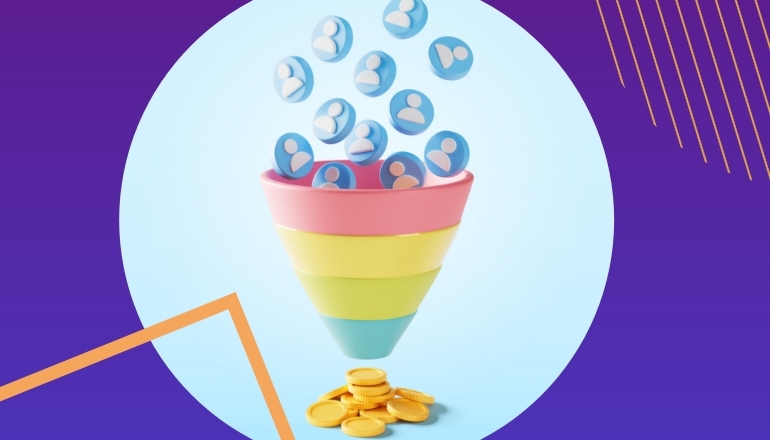
Is your sales pipeline delivering engaged, qualified leads? Is there friction in your process that could be holding back deals? Are gaps in communications driving inefficiencies? Are you collecting the right information to power data-driven decision-making? Is your ICP well-calibrated, or are you falling into the "spray and pray" trap?
If you could use some improvement in any of these areas, check out our 5 Best Practices to Improve Pipeline Management.
#1: Decoding Lead Intent and Readiness
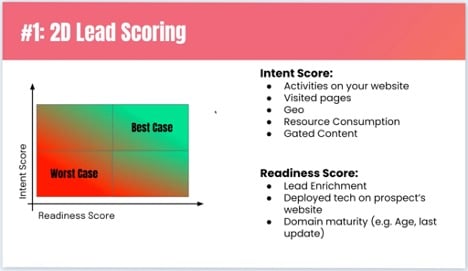
Effectively managing pipelines relies on lead scoring, a key practice that transforms raw data into actionable insights. Whether through manual, dynamic, or AI-driven methods, your lead scoring should feature a two-dimensional approach that assesses your prospect's intent and readiness.
The intent score reveals the real-time intentions of visitors on your website, offering insights into whether they're researching solutions or exploring alternatives.
The readiness score, on the other hand, gauges a lead's preparedness to effectively use your product or service.
When designing your scoring model, collaboration between departments is paramount. While the marketing team usually takes the lead, involving sales, DevOps, and marketing operations ensures that the scoring model adapts to evolving business needs. This is a continuous process that demands ongoing fine-tuning and calibration.
#2: Strengthening Collaboration & Removing Bottlenecks
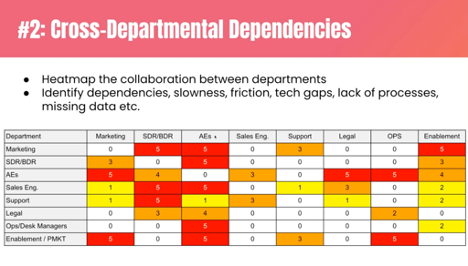
Effective pipeline management isn't just about isolated tasks within individual departments; it's a coordinated effort that spans multiple teams. Teams that communicate and coordinate will be able to understand and refine the interactions between various departments.
One key insight from this approach is the emphasis on people alongside data. Instead of relying solely on reports and data analysis, get your team together and discuss:
- What strategies are working?
- Where are we missing data?
- What processes are causing challenges?
- Where are our bottlenecks?
We recommend putting together a heat map like the one shown above. This offers a clear visual representation of problematic areas. For instance, if a certain aspect of the process is consistently rated as a "5" on the heat map, it indicates a significant bottleneck that needs attention.
Once you have identified any issues, you can do a deeper dive into understanding their root causes.
As the business landscape evolves, so must the strategies for cross-departmental collaboration. Factors like changes in personnel or shifts in business priorities may impact established workflows, necessitating periodic reassessment.
#3: Avoiding Avoidable Inefficiencies
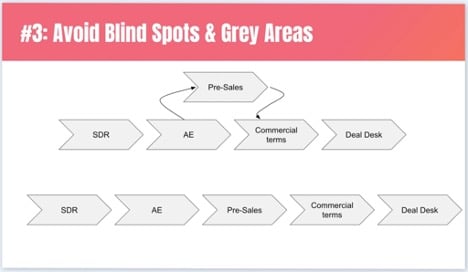
Avoiding the blind spots and gray areas within your sales process can also significantly enhance your pipeline management.
These concealed gaps, often existing between departments and stages, can impede smooth progression and lead to avoidable inefficiencies.
For example, a common blind spot emerges when the technical aspects of sales—like pre-sales or technical demonstrations—are not integrated into the sales cycle. This disconnect can hinder accurate reporting and accountability, as the presales team can become isolated and less aligned with the sales process.
Moreover, the lack of granularity in the early stages of the selling system can lead to missed opportunities and protracted timelines. Many businesses tend to focus their efforts on later stages, such as negotiation, commercial discussions, and legal procedures. However, neglecting the initial stages can result in crucial misalignments and bottlenecks that could have been avoided.
Three easy steps to address misalignments and bottlenecks:
- Ensure that all processes happening within each opportunity stage are reflected in your deal stages. Measuring how much time is spent in each opportunity stage can give you visibility into where time is being lost, allowing you to pinpoint areas that require attention.
- Design processes for effective handoffs, both internally and externally with the customer. The transition of information from one stage to the next must be seamless. Whether through notes, recordings, or summarized insights, the aim is to ensure that the next person in line understands the context and can proceed without repeating or misinterpreting previous interactions.
- Instill a culture of continuous feedback. After each interaction, review the main takeaways, what worked well, and what could be enhanced.
#4: Removing the "Other" Option For Lost Reason
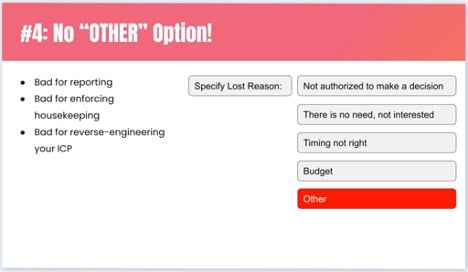
Don't include an "Other" option on your list of lost reasons.
Why? Because people will use it!
When sales team members are trying to move quickly and just get through their day, they will take the shortcut and just click "Other." That option doesn't give you any valuable information.
Adding a longer list of Lost Reasons and eliminating the "Other" option will provide you enough granularity to make strategic decisions and become more data-led.
Furthermore, clear definitions of the options in your Lost Reasons list are crucial. For instance, one commonly misunderstood term is "budget." What does budget mean exactly?
Make sure that each Lost Reason has a distinct and universally understood definition. This clarity ensures that everyone across the organization interprets these reasons consistently.
By understanding the specific reasons you lost a deal, your organization can fine-tune your Ideal Customer Profile (ICP) and lead generation strategies. These insights enable you to address missing features, pricing misalignments, budget constraints, or other factors that may have contributed to the loss. Armed with this information, you can strategically nurture these lost prospects, maintaining engagement and readiness for when they might be ready to reconsider.
#5: Calibrating for the Ideal Customer Profile (ICP)
.png?width=468&height=272&name=Ideal%20Customer%20Profile%20(ICP).png)
When you've got hiccups, performance issues, friction, missing technologies, or missing processes, eventually non-ideal customers will slip through the cracks and find their way into your funnel. Then, because the Ideal Customer Profile (ICP) is not well-engineered, the sales rep could spend a lot of time qualifying leads that should not be in the pipeline in the first place because they don't fit your ICP.
When your ICP is not well calibrated, and you end up "spraying and praying," the entire business loses money, time, and effort.
The solution to this is to develop a success-based Ideal ICP, which involves reverse engineering what defines success within your customer base.
Begin at the end of the customer lifecycle, where you have a book of loyal customers, top contributors, and low contributors. Determine what characteristics define success within your customer base. This could include factors like domain age, deployed technologies, business data, and more.
By identifying these success signals, you can develop a more precise ICP. Rather than casting a wide net, you'll focus on a smaller, highly targeted pool of leads that closely resemble your top customers. This approach optimizes the quality of leads entering your funnel and reduces the noise caused by irrelevant or mismatch.
Implementing these best practices can reshape the way organizations approach revenue generation. For a deeper dive on this topic, check out our recent webinar with Avner Baruch, Director of Revenue Ops & Sales Enablement at Rapyd.
Stay updated with our HubSpot Hacks webinars.






